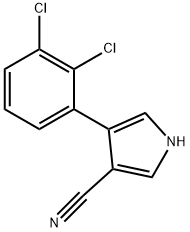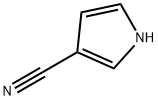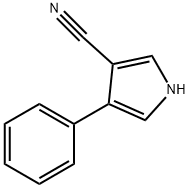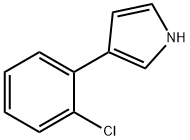FENPICLONIL
- CAS NO.:74738-17-3
- Empirical Formula: C11H6Cl2N2
- Molecular Weight: 237.08
- MDL number: MFCD00144304
- SAFETY DATA SHEET (SDS)
- Update Date: 2023-04-23 13:52:06

What is FENPICLONIL?
Description
Fenpiclonil is the first phenylpyrrole fungicide developed by Ciba Geigy (now belonging to the portfolio of Syngenta Crop Protection AG) for seed treatment. Different formulation types have been used for its commercialization either in solo (trade name “Beret”) or in mixture with other fungicides, as for instance, imazalil (“Beret Special”) or carboxin + imazalil (“Beret Universal”).
The Uses of FENPICLONIL
Fenpiclonil is a systemic and contact fungicide that provides protective control of seed-borne pathogens of cereals such as snow mould and bunt caused by Fusarium spp., Tilletia caries, Septoria nodorum, etc. It also controls leaf spot, brown foot rot and ear blight in non-cereal crops.
The Uses of FENPICLONIL
Agricultural fungicide.
Definition
ChEBI: A member of the class of pyrroles carrying cyano and 2,3-dichlorophenyl substituents at positions 3 and 4 respectively. A fungicide used mainly to control seed-borne pathogens in cereal crops.
General Description
Fenpiclonil is a phenylpyrrole fungicide and a structural analogue of the antibiotic pyrrolnitrin found to be toxic to representatives of Ascomycetes, Basidiomycetes, and Deuteromycetes.
Metabolic pathway
Limited data are available in the open literature. Information presented in this summary was abstracted from the data evaluation published by the Pesticide Safety Directorate (PSD, 1993). Fenpiclonil is stable to hydrolytic and soil degradation. Photolytic degradation is rapid. Hydroxylation and oxidation of the pyrrole ring are the primary metabolic reactions in plants and animals (Scheme 1).
Degradation
Fenpiclonil (1) is stable to hydrolytic degradation (up to 70 °C) over the
pH range 5-9.
Fenpiclonil degraded rapidly in water (pH 7) when samples were
irradiated under a mercury arc lamp (>290 nm) with an estimated DT50
values of <1 hour. At least eight unidentified degradation products were
observed
Properties of FENPICLONIL
| Melting point: | 152.9℃ |
| Boiling point: | 378.43°C (rough estimate) |
| Density | 1.4052 (rough estimate) |
| vapor pressure | 1.1 x 10-7 Pa (25 °C) |
| refractive index | 1.6400 (estimate) |
| pka | 13.63±0.50(Predicted) |
| form | neat |
| Water Solubility | 4.8 mg l-1 in water at 25 °C |
| Merck | 13,4016 |
| BRN | 5433281 |
| EPA Substance Registry System | 1H-Pyrrole-3-carbonitrile, 4-(2,3-dichlorophenyl)- (74738-17-3) |
Safety information for FENPICLONIL
| Signal word | Warning |
| Pictogram(s) |
 Exclamation Mark Irritant GHS07 |
| GHS Hazard Statements |
H332:Acute toxicity,inhalation |
| Precautionary Statement Codes |
P261:Avoid breathing dust/fume/gas/mist/vapours/spray. P271:Use only outdoors or in a well-ventilated area. |
Computed Descriptors for FENPICLONIL
New Products
4-AMINO-TETRAHYDRO-PYRAN-4-CARBOXYLIC ACID HCL 4-(Dimethylamino)tetrahydro-2H-pyran-4-carbonitrile 4-Aminotetrahydropyran-4-carbonitrile Hydrochloride (R)-3-Aminobutanenitrile Hydrochloride 3-((Dimethylamino)methyl)-5-methylhexan-2-one oxalate 1,4-Dioxa-8-azaspiro[4.5]decane 5-Bromo-2-nitropyridine Nimesulide BP Aceclofenac IP/BP/EP Diclofenac Sodium IP/BP/EP/USP Mefenamic Acid IP/BP/EP/USP Ornidazole IP Diclofenac Potassium THOMAIND PAPER PH 2.0 TO 4.5 1 BOX BUFFER CAPSULE PH 9.2 - 10 CAP SODIUM CHLORIDE 0.1N CVS ALLOXAN MONOHYDRATE 98% PLATINUM 0.5% ON 3 MM ALUMINA PELLETS (TYPE 73) LITHIUM AAS SOLUTION 2-Bromo-1-(bromomethyl)-3-chloro-5-nitrobenzene 2-Bromo-3-nitroaniline N-(3-Hydroxypropyl)-N-methylacetamide 3-Bromo-6-chloropyridazine 4-ethyl-3-nitrobenzoic acidRelated products of tetrahydrofuran






You may like
-
 Fenpiclonil CAS 74738-17-3View Details
Fenpiclonil CAS 74738-17-3View Details
74738-17-3 -
 1-Methyl-6-oxo-1,6-dihydropyridazine-3-carbonitrile 98%View Details
1-Methyl-6-oxo-1,6-dihydropyridazine-3-carbonitrile 98%View Details
99903-60-3 -
 1823368-42-8 98%View Details
1823368-42-8 98%View Details
1823368-42-8 -
 2-(3-(tert-butyl)phenoxy)-2-methylpropanoic acid 1307449-08-6 98%View Details
2-(3-(tert-butyl)phenoxy)-2-methylpropanoic acid 1307449-08-6 98%View Details
1307449-08-6 -
 Ethyl 3-(furan-2-yl)-3-hydroxypropanoate 25408-95-1 98%View Details
Ethyl 3-(furan-2-yl)-3-hydroxypropanoate 25408-95-1 98%View Details
25408-95-1 -
 2-Chloro-5-fluoro-1-methoxy-3-methylbenzene 98%View Details
2-Chloro-5-fluoro-1-methoxy-3-methylbenzene 98%View Details
1805639-70-6 -
 1784294-80-9 98%View Details
1784294-80-9 98%View Details
1784294-80-9 -
 Lithium ClavulanateView Details
Lithium ClavulanateView Details
61177-44-4